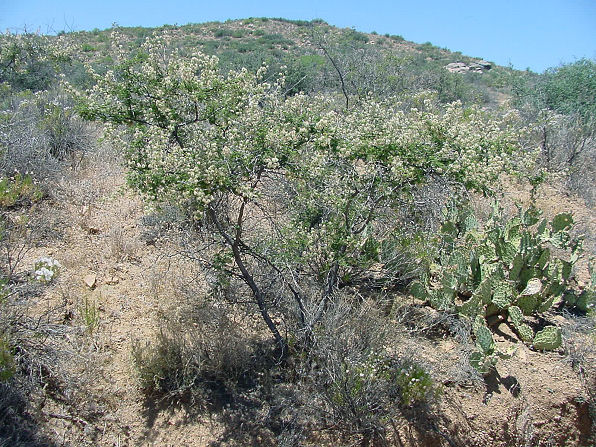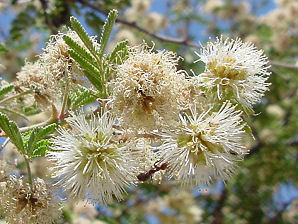Arizona Wild Flowers
Pictures, Photos, Images
Descriptions, Information, Reviews.
Catclaw Mimosa, Mimosa aculeaticarpa biuncifera.
We Are Proud Of Our SafeSurf Rating!
Click On Any Of The Following Links By Amazon.Com
For Books, & Videos About Wildflowers Of Arizona & The Southwest USA. No Obligation!
 |
| Catclaw Mimosa, Mimosa aculeaticarpa var. biuncifera Photo Taken June 13, 2003 At Date Creek, Arizona. |
|---|
 |  |
| Wait A Minute Bush. | Mimosa aculeaticarpa biuncifera. |
|---|
Catclaw Mimosa.
We wish to thank Wikipedia, the free encyclopedia for some of the information on this page. We share images and information with Wikipedia. The Wait-A-Minute Mimosa bears fragrant, pale pinkish to creamy flowers, in globose heads, in late spring to mid summer. The fruits are curved or straight legumes, 0.8 to 1.5 inch long, 0.12 to 0.16 inch wide, constricted between the seeds. Thicket forming, deciduous shrub, 3 to 8 feet tall ; pubescent stems with single or paired prickles; bipinnately compound leaves with 3 to 9 pairs of pinnae each with 8 to 14 pairs of obtuse, linear to oblong, 0.08 to 0.16 inch long leaflets. Found in the Sonoran and Chihuahuan deserts: USA (southern Arizona, southern New Mexico, western Texas), northern Mexico, in dry soils on mesas and rocky slopes, at 2,000 to 5,600 feet elevation. The elevation is dependent upon which state the plant is located in. This plant is often called Cat Claw, due to its cat-like claws on all of it's branches. The claws are much more dense and more numerous than those of Catclaw Acacia (Acacia gregii), which it sometimes confused. Other distinctions between these two plants are that the Wait-A-Minute has much smaller leaves and leaflets, and is normally a smaller plant. A host plant to the Cecrops eyed silkmoth (Automeris cecrops). Mearns' quail also are associated with this plant. Honeybees are attracted to this plant and produce a very delicious honey from it. It is a honey that we try to produce from our bees, every year. Catclaw blooms just about after the mesquite bloom.
Quick Notes:
Height: About 3 - 8 feet. Can reach 10 feet.
Flowers: White to pinkish small fuzzy spheres; in a tight elongated, showy clusters, 2 to 3 inches long, fragrant, appearing in spring and early summer. Inflorescences, axillary spikes.
Flowering Time: April to July.
Leaves: The leaves are alternate, bipinnately compound leaves with 3 to 9 pairs of pinnae each with 8 to 14 pairs of obtuse, linear to oblong, 0.08 to 0.16 inch long leaflets.
Stems/Trunks: An attractive gray shaggy - rough trunk; pubescent stems with single or paired prickles.
Seed Pod: Curved or straight legumes, 0.8 to 1.5 inch long, 0.12 to 0.16 inch wide, constricted between the seeds, brown, maturing in mid to late summer.
Found: Southwestern United States (AZ, NM, TX); and northern Sonora, & Baja California, in Mexico.
Hardiness:
Soil pH requirements:
Sun Exposure:
Elevation: 3,000 - 6,500 Feet.
Habitat: Washes, flats and canyons below 6500', creosote bush scrub, Chapparal, Grasslands, dry habitats, dry soils on mesas and rocky slopes.
Miscellaneous: Flowering Photos Taken June 13, 2003 At Date Creek, Arizona.
|
We Are Proud Of Our SafeSurf Rating!
Click On Any Of The Following Links By Amazon.Com
For Books, & Videos About Wildflowers Of Arizona & The Southwest USA. No Obligation!
| © 1966 - Present, Audrey, Eve, & George DeLange |
